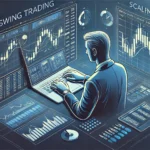Day Trading Strategies That Actually Work in 2025
Day trading is both popular and challenging. Markets keep changing, so traders must keep up with the latest strategies. This guide will cover the best day trading methods for 2025, tools to use, and how to manage risks.
Understanding Day Trading in 2025
Day trading means buying and selling financial items in one day. It aims to make money from quick price changes. With new tech and market changes, 2025 offers both new chances and challenges for traders.
Top Day Trading Strategies for 2025
| Strategy | Best for | Key Advantage |
|---|---|---|
| Momentum Trading | Beginners & Pros | Captures strong price movements |
| Scalping | High-frequency traders | Quick profits on small moves |
| Breakout Trading | Trend followers | Profits from new highs/lows |
| Reversal Trading | Experienced traders | Capitalizes on trend reversals |
| Algorithmic Trading | Tech-savvy traders | Automated decision-making |
1. Momentum Trading
Momentum trading focuses on stocks or assets with big price changes. Traders look for assets with strong trends and enter positions in the direction of the momentum.
How to Implement:
Identify stocks with high relative volume
Use technical indicators like RSI and MACD
Set stop-loss levels to minimize risks
2. Scalping
Scalping is a high-frequency trading strategy. Traders make many small trades a day, taking advantage of tiny price movements.
How to Implement:
Focus on highly liquid assets with tight spreads
Execute trades using direct market access (DMA) brokers
Use automated trading software for rapid execution
3. Breakout Trading
Breakout traders enter trades when an asset moves beyond a defined support or resistance level. They aim to profit from increased volatility.
How to Implement:
Identify key support/resistance levels
Use volume indicators to confirm breakouts
Avoid false breakouts with proper risk management
4. Reversal Trading
Reversal traders look for signs that a strong trend is about to change direction. This strategy requires experience and careful analysis.
How to Implement:
Use candlestick patterns like Doji or Hammer
Monitor divergences in RSI and MACD
Set tight stop-loss levels to control risk
5. Algorithmic Trading
Algorithmic trading uses automated systems to make trades based on set rules. Thanks to AI, this method is getting better in 2025.
How to Implement:
Develop or buy a trading bot
Test algorithms with past data
Use AI to make strategies better
Risk Management for Day Trading
Day traders must manage risk to keep their money safe. Here are some key tips:
Position Sizing: Risk only 1-2% of your total capital per trade
Stop-Loss Orders: Set automatic exits to limit losses
Diversification: Trade different assets to spread out risk
Trading Journal: Keep track of trades to learn from them
Essential Tools for Day Traders in 2025
Trading Platforms: MetaTrader 5, ThinkorSwim, NinjaTrader
Charting Software: TradingView, TrendSpider
News Aggregators: Bloomberg Terminal, Reuters
AI-Based Trading Assistants: Trend AI, Quantum Trading Bot
Common Mistakes to Avoid in Day Trading
Overtrading: Taking too many trades can lead to high costs and risk
Ignoring Risk Management: Not using stop-loss orders can cause big losses
Emotional Trading: Letting fear or greed guide your decisions
Lack of Preparation: Trading without a solid plan
Conclusion
Day trading in 2025 is exciting but requires discipline and strategy. By mastering strategies like momentum and scalping, traders can make more money. Advanced tools and AI analytics help stay ahead in the market.
FAQs
1. Is day trading profitable in 2025?
Yes, but success depends on strategy, risk management, and market knowledge. Traders using AI tools and disciplined approaches tend to do better.
2. What is the best market for day trading?
Forex, stocks, and cryptocurrency are top choices due to their liquidity and volatility.
3. Can I start day trading with $500?
Yes, but starting with at least $1,000 is recommended for better risk management.
4. Do I need AI for day trading?
AI isn’t necessary, but it helps analyze data, predict trends, and automate trades more efficiently.
5. How can I avoid emotional trading?
Use a trading plan, follow risk management rules, and avoid revenge trading after losses.














